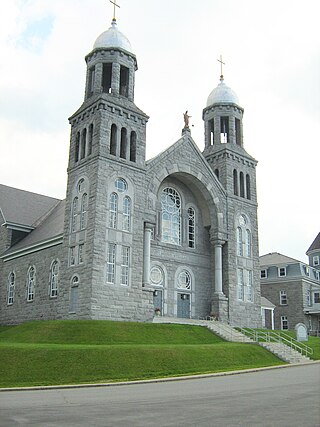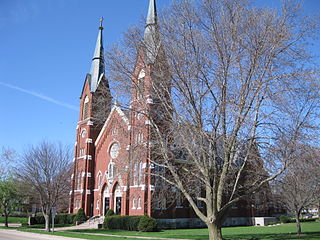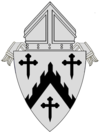
Sacred Heart Cathedral, located in Davenport, Iowa, United States, is a Catholic cathedral and a parish church in the Diocese of Davenport. The cathedral is located on a bluff overlooking the Mississippi River to the east of Downtown Davenport. It is listed on the National Register of Historic Places as part of the Sacred Heart Roman Catholic Cathedral Complex. This designation includes the church building, rectory, and the former convent, which was torn down in 2012. The cathedral is adjacent to the Cork Hill Historic District, also on the National Register. Its location on Cork Hill, a section of the city settled by Irish immigrants.
Aloysius Joseph Schulte (1858–1940) was an American Catholic priest and academic who served as the first president of St. Ambrose College in Davenport, Iowa, from 1882 to 1891.

St. Mary Star of the Sea, a Roman Catholic church, is located at the crest of Prospect Street, Newport, Vermont, overlooking Lake Memphremagog. It serves a community of more than 1000 families.

St. Mary's Catholic Church, also known as St. Mary of the Visitation Church, is a parish church of the Diocese of Davenport which is located in Iowa City, Iowa, United States. The church building and rectory were listed together on the National Register of Historic Places in 1980. They were both included as contributing properties in the Jefferson Street Historic District in 2004. The parish's first rectory, which is now a private home, is also listed on the National Register as St. Mary's Rectory. It is located a few blocks to the east of the present church location at 610 E. Jefferson St.

St. Anthony's Catholic Church is a parish church in the Diocese of Davenport. The parish complex is located in downtown Davenport, Iowa, United States, at the corner of Fourth and Main Streets. It is the first church congregation organized in the city of Davenport and the second Catholic congregation, after St. Raphael's in Dubuque, in the state of Iowa. The parish buildings were listed on the National Register of Historic Places as St. Anthony's Roman Catholic Church Complex in 1984. The designation includes the church and the former school building, which is the parish's original church building and the oldest standing church building in Iowa. The designation also included the rectory, which was partially torn down in 2009. The complex was also listed on the Davenport Register of Historic Properties in 1992 as St. Anthony's Church Square. The property has been known historically as Church Square. In 2020 the parish buildings, except for the parish center, were included as contributing properties in the Davenport Downtown Commercial Historic District. Because of its recent construction date, the parish center is excluded as a contributing property.

The Church of All Saints is a parish of the Catholic Church in the Diocese of Davenport. The church is located in Keokuk, Iowa, United States. The church building is listed on the National Register of Historic Places as St. Peter Church, the name of the congregation that built it.

St. Mary's Catholic Church was a parish of the Diocese of Davenport. The church building is located in the west end of Davenport, Iowa, United States, at the corner of Fillmore and W. 6th Streets. It is listed on the National Register of Historic Places as St. Mary's Roman Catholic Church Complex. The designation includes the church building and rectory on the west side of Fillmore Street, and the former parochial school building and convent on the east side. A former school building operated by the parish two blocks north on West Eighth Street is also on the National Register and is listed as St. Mary's Academy. The parish ceased operations in July 2020 when it was merged into St. Anthony's Church downtown. The parish campus is being acquired by the nonprofit organization Humility Homes & Services, which is operated by the Congregation of the Humility of Mary.

St. Joseph Catholic Church is a former Catholic parish in the Diocese of Davenport. Its former parish church is located in the west end of Davenport, Iowa, United States. It was listed on the National Register of Historic Places in 1983. The church and the rectory were listed together on the Davenport Register of Historic Properties in 1999. After serving as the location of a Reformed Baptist congregation and a private elementary school named Marquette Academy, the parish property now houses an evangelical Christian ministry named One Eighty.

St. Mary of the Visitation Catholic Church is a parish of the Diocese of Davenport. The church building is located on the corner of 4th and Court Streets in downtown Ottumwa, Iowa, United States. It is part of the Central Park area, which is the civic center of the community. It includes: the Wapello County Courthouse, the Ottumwa Public Library, and the Ottumwa City Hall. The church is eligible for the National Register of Historic Places, but it has not been listed.

St. Mary's Catholic Church is a parish church of the Diocese of Davenport. The church is located at the corner of St. Mary's and Washburn Streets in the town of Riverside, Iowa, United States. The entire parish complex forms an historic district listed on the National Register of Historic Places as St. Mary's Parish Church Buildings. The designation includes the church building, rectory, the former church, and former school building. The former convent, which was included in the historical designation, is no longer in existence.

St. Mary's Catholic Church is a parish of the Archdiocese of Dubuque. The church is located in Guttenberg, Iowa, United States. It is listed on the National Register of Historic Places as St. Mary's Catholic Church Historic District. In addition to the church, the historic district includes the parish rectory, convent, and school building.

Saint Irenaeus Church is a former parish of the Diocese of Davenport. The church was founded in the town of Lyons, which now the north side of Clinton, Iowa, United States. It has been listed on the National Register of Historic Places since 2010.

The Cathedral of the Holy Angels is a Catholic cathedral located in Gary, Indiana, United States. It is the seat of the Diocese of Gary, and the home of Holy Angels Parish.

The Cathedral of Mary the Assumption, also known as St. Mary's Cathedral, is a Catholic cathedral and parish church located in Saginaw, Michigan, United States. It is the seat of the Diocese of Saginaw. In 1979 it was included as a contributing property in the Saginaw Central City Historic Residential District on the National Register of Historic Places.

The Cathedral of St. Mary of the Assumption, also known simply as St. Mary's Cathedral, is the Catholic cathedral in Trenton, New Jersey, United States. Along with the Co-Cathedral of St. Robert Bellarmine in Freehold, it is the seat of the Diocese of Trenton.

Immaculate Conception Academy, known locally as ICA, was a Catholic girls' high school located in Davenport, Iowa, United States. It was begun by the Sisters of Charity of the Blessed Virgin Mary (BVM) in 1859 and it remained in operation until it merged with St. Ambrose Academy in 1958 to form Assumption High School. The academy building remains in use as an academic building on the campus of Palmer College of Chiropractic.

St. Boniface Church is a former parish church of the Diocese of Davenport. The church was founded in the town of Lyons, which is now the north side of Clinton, Iowa, United States. The church building is now a museum named The Catholic Historical Center at St. Boniface, with exhibits about the history of the Clinton area Catholic community, and an archive of local Catholic church artifacts and records. The church was listed on the National Register of Historic Places in 2012.

St. Paul's Catholic Church is a historic church building located in Burlington, Iowa, United States. Together with the Church of St. John the Baptist in Burlington and St Mary's Church in West Burlington it forms Divine Mercy parish, which is a part of the Diocese of Davenport. The parish maintains the former parish church buildings as worship sites. St. Paul's Church and the rectory are contributing properties in the Heritage Hill Historic District listed on the National Register of Historic Places. St. Paul's School was also a contributing property in the historic district, but it has subsequently been torn down.

The St. Joseph's Church Complex is a collection of historic buildings located in Fort Madison, Iowa, United States. At one time the complex housed a Catholic parish in the Diocese of Davenport. St. Joseph and St. Mary of the Assumption parishes merged in the 1990s to form Saints Mary and Joseph Parish. In 2007 when that parish merged with Sacred Heart on the west side to form Holy Family Parish, St. Joseph's Church was closed. The former church, chapel, rectory, convent, and school were included as contributing properties in the Park-to-Park Residential Historic District that was listed on the National Register of Historic Places in 2014.

Sacred Heart Church is a parish church of the Diocese of Columbus in the Italian Village neighborhood of Columbus, Ohio. The parish was founded in 1875, making it the third-oldest parish in the diocese. The current Tudor Gothic church was completed in 1923.
























